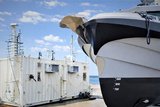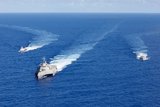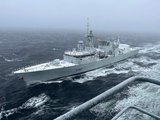Hydroid passes CDR for littoral battlespace AUVs
Hydroid Inc. announces that it has passed Critical Design Review (CDR) to provide Littoral Battlespace Sensing (LBS) Autonomous Undersea Vehicles (AUVs) and associated technologies to the Space and Naval Warfare Systems Command (SPAWAR).
The Critical Design Review was held to verify that Hydroid is in compliance with design maturity requirements and that detailed design preparations are in place to proceed with system fabrication, demonstration, and testing. The Navy's lead evaluator noted that the Program is progressing in a manner that will be most beneficial to the Navy and enhance the characterization of the battlespace essential to the warfare areas.
The recognition of CDR is the next milestone in Hydroid's contract to provide SPAWAR with REMUS 600 AUVs equipped with technologies for meteorological and oceanographic data collection, as well as technologies for processing and dissemination of these data. This technology will enable superior decision making based on information that is collected by a system of networked sensors and shared through a network of interoperable Naval and Joint networks information systems. The ultimate end user for the contract is the Naval Oceanographic Office (NAVOCEANO), who acquires the relevant data and provides specialized services to all elements within the Department of Defense.
"We're so pleased to reach this milestone with SPAWAR's Littoral Battlespace Sensing program", says Chris von Alt, President and a co-founder of Hydroid. "We share this recognition with our strong team of collaborative partners, including Kongsberg Maritime, Kongsberg Underwater Technology, Inc., Whitney, Bradley & Brown (WBB) and Dayton T. Brown."
The Cost Plus Incentive Fee and Firm Fixed Price competitive contract includes incentives and options, and has a ceiling of approximately $77 Million (USD). The work will be performed at Hydroid's headquarters in Pocasset, MA, and the Engineering Development Model (EDM) phase is expected to be completed by April 2012. If all options are exercised, deliveries of LBS-AUVs will continue through 2017.
Hydroid's REMUS AUVs are modular and may be fitted with a large number of different types of sensors and have been used to aid in hydrographic surveys, harbor security operations, debris field mapping, scientific sampling and mapping, as well as many basic and applied research programs funded by ONR, DARPA and the United Kingdom Ministry of Defense. With over 200 vehicles in the field, Hydroid is currently the AUV market leader with systems in use by thirteen NATO and other navies around the world.
Source: Kongsberg
More from Uncrewed Vehicles
-
![What's next for the Pentagon after the Replicator programme?]()
What's next for the Pentagon after the Replicator programme?
Although the Replicator initiative has made several accomplishments, there are still multiple gaps to plug across the US Department of Defense (DoD) and its services.
-
![Cummings Aerospace showcases Hellhound loitering munition designed for US Army’s LASSO programme (video)]()
Cummings Aerospace showcases Hellhound loitering munition designed for US Army’s LASSO programme (video)
Cummings Aerospace presented its turbojet-powered Hellhound loitering munition at SOF Week 2025, offering a man-portable solution aligned with the US Army’s LASSO requirements.
-
![SOF Week 2025: PDW unveils attritable FPV drone for SOF operations at scale]()
SOF Week 2025: PDW unveils attritable FPV drone for SOF operations at scale
PDW has revealed its Attritable Multirotor First Person View drone at SOF Week 2025, offering special operations forces a low-cost, rapidly deployable platform for strike and ISR missions, inspired by battlefield lessons from Ukraine.
-
![SOF Week 2025: Teledyne FLIR white paper provides guidance on reusable loitering munitions]()
SOF Week 2025: Teledyne FLIR white paper provides guidance on reusable loitering munitions
Teledyne FLIR is highlighting the emerging requirements for 'recoverable and re-usable' loitering munitions across the contemporary operating environment during this week’s SOF Week conference in Tampa, Florida.
-
![SOF Week 2025: Kraken Technology group debuts K3 Scout USV in North America]()
SOF Week 2025: Kraken Technology group debuts K3 Scout USV in North America
High-performance maritime industry player Kraken Technology Group, based in the UK, has used the SOF Week conference in Tampa, Florida this week to debut its K3 Scout uncrewed surface vessel (USV) to the North American market.
-
![Palladyne AI and Red Cat to demonstrate capabilities for autonomous drone swarms to the US military]()
Palladyne AI and Red Cat to demonstrate capabilities for autonomous drone swarms to the US military
Red Cat and Palladyne AI recently conducted a cross-platform collaborative flight involving three diverse heterogeneous drones.

























